PSEB 12th Class Physical Education Practical Lawn Tennis
Lawn Tennis Game History
Lawn tennis was started in France in 12th century and was known as paume. This word means ‘Palm of hand’. (Robin Hood) Tennis is an Olympic sport and it is played by all societies world wide. The Lawn Tennis was invented by French monk around 11-12th century 7 and was known as “Paume” that time. It is developed and shaped up into Modern game in 1872 and First Tennis Club was started named as Hoa Pereira.In the 19th century tennis started to spread throughout English colonies. The first amateur championship was played at court called Wimbledon. The first men’s official championship was played in 1877 and women’s championship in 1884. 1900, was the year when Davis cup started. Tennis has been an Olympic Sport since 1988. In India, first National Championship was held in 1946 at Kolkata.
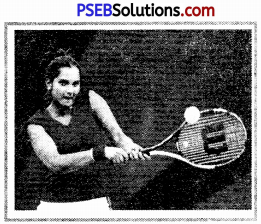
![]()
Lawn Tennis Game Important Points
- Length of the Court:23.77 m
- Breadth of the Court:8.23 m (singles), 10.97m (doubles)
- Height of Posts:1.7 m
- Distance of the Centre of the Post:0.91 m (in centre)
- Diameter of the Posts:15 cm
- Height of the Net:0.91 m
- Width of the Strap:5 cm
- Distance of Service Lines:6.40 m
- Width of the Court Service Line:5 cm
- Weight of Racket:395 gm
- Length of the Racket:27 inches
- Weight of the Ball:56.7 to 58.5 gm
- Diameter of the Ball:6.35 to 6.67 cm
- Maximum Number of Set of a Game in Single:5 (men) 3(women)
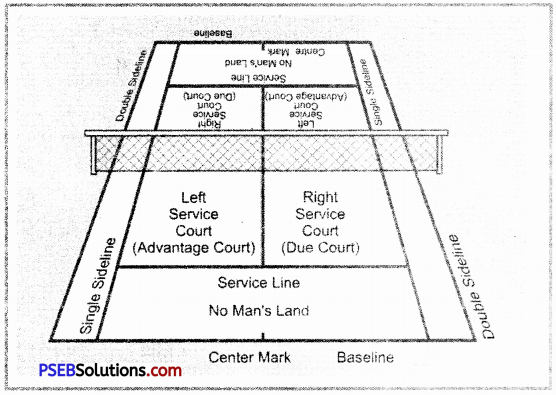
![]()
1. Tennis Racket:
The size and weight of tennis racket is not mentioned in the rule however most of the rackets are 21″ long. Mostly men j choose a racket that weigh about 395 gms. Whereas women choose that weigh about I 365 gms. Die modem tennis rackets are made of fibre glass and graphite.
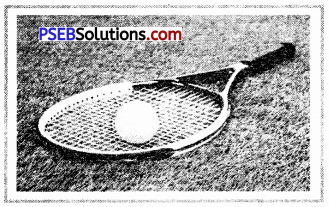
2. Tennis Ball:
The tennis ball is made of rubber and is covered with fabric wool. Its diameter is 6.35 cm to 6.67 cm. It must weigh between 56.7 to 58.5 gms. The colour of the ball is yellow or white.
3. Court:
The tennis court is rectangular in shape and is divided into 2 halves by a net. The court is 23.40 m in length and 8.10 m in width for singles and 10 97 m in width for doubles.
4. The Net:
The net is suspended across the court by a cable, The height of the net at the middle is 0.91 m. A narrow cloth strap in the middle holds the net tight.
![]()
Lawn Tennis Game Rules And Regulations
1. Toss:
The game starts with the toss which is done with the help of racket. After winning the toss, a player can choose to serve or to decide the court,
2. Service:
The service is delivered from a position in rear of the base line and from within imaginary continuations of the centre line and side lines.
3. Foot Fault:
The server may not walk, run and jump clear of the ground, nor step over the base line while delivering the service. One foot must remain in contact with the ground.
4. Alternating Service:
Service is delivered from alternate sides of the court, beginning from the right. The ball served shall pass over the net and strike the ground within the diagonally opposite service court.
5. Service Fault:
The service is a fault if, besides foot faults, the ball is missed in the attempt to strike it if the ball served touches a permanent fixture (other than net, strap or band) before it strikes the ground.
6. Faults Allowed:
The server is allowed another try at service, from the same half of the court, if the first serve has resulted in a fault. A second fault will result in a score for the opponent.
7. Let:
If the ball served touches the net, strap or band, it is a let, provided the ball falls into the proper service court, otherwise it is a fault. In the case of a let the service shall not be counted and the server shall serve again. A let does not annual the previous fault.
8. Receiver becomes Server:
At the end of a game the receiver shall become the server and vice versa, alternating in all subsequent games of a match.
9. Server Wins Point: If the ball served touches the receiver or anything which he wears or carries.
10. Receiver Wins Point: If the server commits two consecutive faults.
11. Player Loses Point:
If he fails to return the ball directly over the net before it strikes the ground a second time, or fails to return the ball directly over the net inside the lines which outline the opponent’s court.
12. Ball Falling On Line: A ball falling on a line is regarded as in the court bounded by that line.
13. Deuce: When both players have scored three points, the score is called Deuce.
14. Scoring:
Tennis consists of 6 games and each game consists of 4 points. These four points are called 15’30’40 and the game points. If both the players score 40-40. The score is called ‘deuce’. To break this tie, one player must win two consecutive points. To win a set one must win six games with at least lead of two games. In case if the game score is 6 all, tie breaker is played. The game is extended to 7 points and the player who wins 7 points with at least margin of 2 points shall be declared winner of the set. A match consists of 5 sets in case of men and 3 sets in case of women.
![]()
Fundamentals:
1. Holding of Racket:
Adjusting the grip you take on a tennis racket is a way of altering the angle of the racket face as it meets the ball. Most of the time, as you trade forehands from the back of the court, you will have your own standard grip based on your strengths and weaknesses. This should change to a different, flatter grip for serves, volleys, smashes and slices. Both grips can be reversed to play backhands, while the two-handed backhand has a grip of its own.
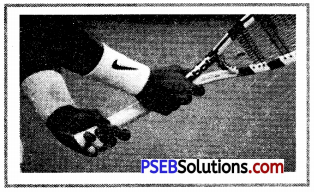
A good way to understand different grips in detail is to move your hand around the handle of the racket in a clockwise motion. Left-handers should move the same distance anti-clockwise in all cases. Imagine that the top of the handle (i.e. the narrow side, looking down on the edge of the frame) is 12 o’clock. The racket is held so that the heel of the hand rests on the leather strip which circles the end of the handle. Then the fingers are wrapped wholly around the handle so that the middle finger locks with the thumb.
2. Eastern Forehand:
Move your hand clockwise around the racket, so that the thumb-finger V is somewhere between 12 and one o’clock. This is an eastern grip, which is similar to w’hat you would get by “shaking hands” with the racket in a very relaxed way. This allows for a small amount of racket acceleration up the back of the ball, which will spin it slightly, keeping the ball relatively flat.
3. Semi-Western:
If you move your hand further round, the wrist comes into play, and it puts the racket into a much deeper position, which allows you to hit up the back of the ball a lot more and generate more spin. If the V is between two and three o’clock, you’re using a semi-western forehand. Somewhere around here is the ideal grip for the modem game, where you’re trying to generate both spin and weight of shot through the ball.
4. Full Western:
With the V anywhere beyond three o’clock, you’d be playing a full western fore hand , which is what a lot of the clay-court Spanish players use. In fact, they twist their grip so far that they actually hit the ball with the opposite face of the racket, which generates an awful lot of racket speed and lines up the strings, so they can spin the ball in a steep low-to-high movement.
5. Eastern Backhand:
To change your grip from a forehand to a one – handed backhand, use the clock principle, starting again from the continental grip but this time moving the same amounts anti-clockwise, depending on how much spin you wish to impart. In practice, most one-handed players stick with a roughly eastern backhand.
6. Two-handed Backhand:
Using a two-handed backhand is a bit like playing a forehand with your wrong hand, so for right-handed players, the left hand does all the work and the right is there solely for support. There are three or four different grips you can use, but a standard two-handed backhand would position the right hand in a neutral continental grip, while the left hand would adopt an eastern forehand grip higher up the racket handle.
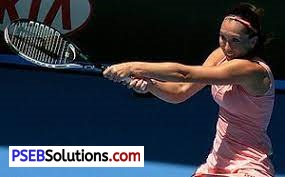
7. The Serve:
Player should stand side wise behind the base line. First, the ball is tossed upward and the stroke begun by swinging the racket downward through an arc, past the right knee, backward and upward behind the head in such a manner as to make contact with the falling ball, in accordance with the type or style of serve planned upon.
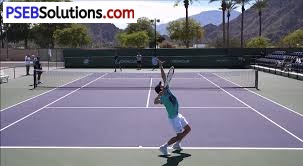
8. Continental Serve:
The basic, neutral grip, known as a continental grip, is formed by placing your hand on the racket so that the V formed by your thumb and forefinger are at toughly 11 o’clock. This is the flat grip you would use to serve, volley or smash. You can also use it to slice a delicate drop shot from the back of the court, as it allows you to hit down on the ball, punching through it to impart backspin.
9. The Forehand Drive:
With the estimate of the place where the ball might bounce, the player stands little bit behind that spot and making pivot of the body, with slightly back swing, he brings the racket forward and hits the ball. The ball is hit when it comes parallel to his knees and waist. Then he comes in the same position after follow through.
10. The Backhand Drive:
The player holds the racket in between. As soon as tire ball approaches him, he turns his shoulders towards the net making pivot of his body, he brings forward the racket from his backside. From full back swing to forward action he strikes the ball with extended arm with follow through.
11. Volley:
A volley is a stroke that meets the ball while it is in flight and before it strikes the ground, usually from a position at the net.
12. Lob: A lob is a variation of the forehand or backhand made with a lifting effect, usually used prolong the flight of the ball.
13. Smash: A smash is a variation of the forehand or backhand with a driving downward effect used in general to return a lob.
14. Drive: A drive is a stroke made with the maximum of speed and power, with due regard for accuracy.
15. Foot Work:
In general there will be almost constant movement of the feet in order to be in the logical place at the right time to receive or deliver the ball, depending upon offensive or defensive intent. Movement of the feet and the general quality of foot work should of course be light, agile and economical, and always regulated to make the stroking accurate and effective.
16. Body Action:
Body action and positions are varied under the same principles that apply to foot work. In general, the body position should be such that one is, whenever possible, sidewise to the net at the moment of stroking. The beginner seems disinclined to depart from the erect posture, whereas positions and movements where the body is extremely extended or sprawled out in wide movements are not unusual, except in one who has had long practice and experience and w’ho, as a result has a fine court sense that enables him to be in the right place at the right time.
17. Arm Action:
The stroking arm should remain supple at all times and mannered actions or positions at the shoulder, elbow and wrist should be avoided. Care should be exercised in the use of the free hand as a balancing agent that it does not fly about violently, thus having a contrary influence.
18. Eyes:
The eyes must remain on the ball at all times. To keep the eyes continuously on the ball is of primary’ importance. Most, if not all, of the errors in stroking will trace back to the fact that the ball was lost sight of at some critical point. Concentration on the spin of the ball will help to confirm the habit of watching the ball.
19. Stroking Effects:
Control of the ball is managed chiefly by the adjustment of the level of the face of the racket at the moment of contact with the ball.
20. Cuts:
The ball is usually met squarely with the face of the racket, but for particular effects or purposes, the racket may be angled as if to cut off the top, bottom or one side of the other of the ball.
21. Spin:
It is possible to cut the ball in a manner contrary to its angle of flight so as to cause the ball to spin, with the result that when it strikes the ground it will bounce off at more or less of an angle to the path flight.
22. Follow Through:
The follow through is very important and consists of continuing the stroke past and beyond the point of contact with the ball in a natural manner.
![]()
Important Terminologies
- Ace: A serve that lands in the service box but is not touched by the receiver is called an ace.
- All: A term used to describe an even score. For example, 15-all is a score of 15-15.
- Backhand: The practice of reaching the arm across the body and hitting the ball with the back of the racket.
- Cross court: A ball hit diagonally into your opponent’s court.
- Deuce: In a 40-40 match, two consecutive points are required to win and are called a deuce.
- Fault: A outside of the box serve.
- Game: Point When one point is required to win the game, the leading player has the game point.
- Hail Mary: The high lob players sometimes use as a defensive move.
- Let: A call for the point to be played again. Interference or a serve hitting the net and bouncing into the service box are usually the reasons.
- Love: The tennis term for “zero”, for example: 15-0 is called as 15-love.
- Match: Point One point away from winning the game.
- Rally: A continuous back and forth series of hits by each player. The rally is over when one player fails to successfully return the ball over the net.
- Singles: A game played with two players, one to each side of the court.
- Touch: A player may not touch the net while the ball is being played. The result is a lost point.
- Volley: Hitting the ball before it bounces on your side of the net.
![]()
Lawn Tennis Game Important Tournaments
International Level
- Wimbledon
- The Grand Slams
- Olympic Games
- National Tennis Championship.
Arjuna Award Winners
- R. Krishnan, Sarabjeet Singh-1961
- Naresh Kumar-1962
- Jwaideep Mukheijee-1966
- Premjeet Lai, Khushi Ram-1967
- Gurdial Singh -1968
- Haridutt-1969
- Vijay Amritraj-1974
- Nirupama Makar-1978-79
- Ramesh Krishnan-1980-81
- Anand Amritraj-1985
- Leander Paes-1990
- Mahesh Bhupati-1995
- Gaurav Nandu Natekar-1996
- Asif Ismael-1998
- Sandeep Kirtne-2002
- Sania Mirza, Archan S. Kamal-2005
![]()
Lawn Tennis Game Important Questions
Question 1.
What is the length of the court?
Answer:
Length of the court is 23.40 m.
Question 2.
What is the breadth of the court?
Answer:
Breadth of the court is 8.10 m.
Question 3.
What is the height of the posts?
Answer:
Height of the posts are 1.07 m.
Question 4.
What is the diameter of the posts?
Answer:
Diameter of posts is 15 cm.
Question 5.
What is the height of net?
Answer:
Height of the net is 0.91 m (in centre).
Question 6.
Define length and weight of the racket for men and women.
Answer:
The length of the rackets is 27″ long. Mostly men choose a racket that weigh about 395 gms whereas women choose that weigh about 365 gms.
![]()
Question 7.
What is the weight of the ball?
Answer:
It must weigh between 56.7 to 58.6 gms.
Question 8.
What is diameter of the ball?
Answer:
Diameter of the ball is 6.35 cm to 6.67 cm.
Question 9.
Explain number of sets for singles.
Answer:
Maximum set for singles in men is 5 and for women it will be 3 sets.
Question 10.
Explain Let.
Answer:
A call for the point to be played again. Interference or a serve hitting the net and bouncing into the service box are usually the reasons.
![]()
Question 11.
What is Deuce?
Answer:
When both players have scored three points, the score is called deuce.
Question 12.
What is All?
Answer:
A term used to describe an even score. For example, 15-all is a score of 15-15.
Question 13.
What is Love?
Answer:
The tennis term for “zero”, for example: 15-0 is called as 15-love.
![]()
Question 14.
Explain Rally.
Answer:
A continuous back and forth series of hits by each player. The rally is over when one player fails to successfully return the ball over the net.
Question 15.
Define Volley.
Answer:
Hitting the ball before it bounces on your side of the net is called volley.
Punjab State Board PSEB 12th Class Physical Education Book Solutions 12th Class Physical Education Practical Lawn Tennis Important Notes, Questions and Answers.
